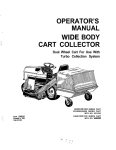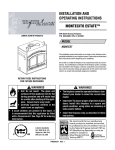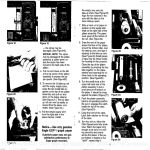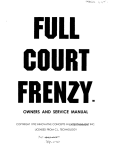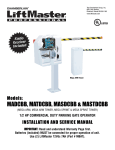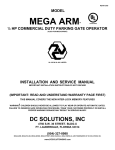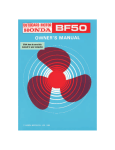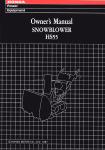Download Simplicity 1692244 Operator`s manual
Transcript
OPERATOR’S MANUAL 47” Two-Stage Commercial Snowthrower Mfg. No. 1692243 Hitch Mfg. No. 1692244 STANDARD FASTENER IDENTIFICATION CHART HEX CAPSCREW CARRIAGE 0 PLAIN WASHER If a washer or nut is identified as “washer, i/2” or “nut, i/2”, this means the inside diameter is l/2 inch BOLT @ @ Hardware sizes given in the illustrations throughout this manual. @ LOCKWASHER NUT If a screw is identified as “screw, i/2 x 2”. this means the shaft diameter is l/2 inch and the shaft of the screw is 2 inches long. If a screw is identified as “screw, i/2 - 16 x 2”, the number “16” means that the screw has 16 threads per inch. SAMPLE: SCREW IDENTIFICATION HEX CAPSCREW IDENTlFlCATlON Shown below are actual size heads for standard screw sizes. Example: a l/4 screw has 7/16 head and thus requires a 7/16 wrench. To measure length, use the scale below. 00000 3lV Head screw with l/2” SD. 5/s” Head screw with 7ll6’S.D. 9/16” Head screw with 318” SD. l/2” Head screw with 5/16” SD. 7/l 6” Head screw with 114” S.D. SAMPLE: NUT IDENTIFICATION WASHER AND NUT IDENTIFICATION Place the washer or nut on the above scale to determine the inside diameter. The actual inside diameter can vary 1116 inch. Use the scale for comparison. Nut, l/2 Inside Diameter TORQUE SPECIFICATIONS FOR STANDARD MACHINE HARDWARE SEE SAE GRADE #2 0 9118-12 9118-18 518-I 1 518-18 314-I 0 314-I 8 718-9 718-I 4 l-8 l-12 N m . 19 20 27 31 66 78 11 12 20 2.1 2.3 3.1 3.5 7.8 8.8 15. 18.3 27.2 31.3 40.8 47.8 88. 74.8 88.4 102. 122.4 138. 217.8 244.8 190.4 210.8 299.2 328.4 30. 35 50 55 85 75 90 100 180 180 140 155 220 240 Q In./Lbs. FtJLbs. 23. SAE GRADE 88 Q InJLbs. 8-32 8-38 lo-24 lo-32 114-20 114-28 5118-18 5118-24 318-18 318-24 7/18-14 7/16-20 l/2-13 l/2-20 SAE GRADE #S FtAbs. 30 31 43 49 8 10 17 19 30 35 50 55 75 90 110 120 150 180 280 300 400 440 580 840 NOTE: 1. These torque values are to be used for all “araware excluding: locknuts, self-tapping screws, thread forming screws, sheet metal screws and socket head setscrews. 2. Recomended seating torque values for locknuts: a. For prevailing torqix locknuts - use 65% of grade 5 torques. b. For flange whizlock nuts (and screws) - use 135% of grade 5 torques. 3. Unless otherwise noted on assembly drawings all torque values must meet this specification. In.1Lb.s. Nm. 3.4 3.5 4.9 5.5 10.9 13.8 23.1 25.8 40.8 47.8 88. 74.8 102. 122.4 149.8 183.2 204. 244.8 353.8 408. 544. 598.4 788.8 870.4 FtJLbs. 41 43 80 68 12 14 25 25 45 50 70 80 110 120 150 170 220 240 388 420 800 880 900 1,000 Nm. 4.8 4.9 8.8 7.7 18.3 19. 34. 34. 81.2 68. 95.2 108.8 149.8 183.2 204. 231.2 299.2 328.4 525. 571.2 818. 897.6 1,224. 1.360. BOLT HEAD MARKING S.A.E. GRADE: SIMPLICITY MANUFACTURING, 500 N. Spring Street Port Washington, Wi 53074 INC. FORM 1709320 PRINTED IN U.S.A. l/95 TABLE OF CONTENTS SECTION PAGE Safety Rules Safe Operation Practices and Precautions ..................................................................................................... 3 Safe Operation of Snowthrower.. ................................................................................................................... .3 Safe Maintenance & Storage.. ............................................ . .......................................................................... .3 Safely Transporting t h e Snowthrower.. .......................................................................................................... .3 Safety Decals ............................................................................................................................................................. 4 Parts Identification .................................................................................................................................................... 5 installation Preparation ........................................................................................................................................ 6 Tractor Flow Reduction Washer ................................................................................................................................. 6 C h u t e Rotator Bracket .................................................................................................................................... 6 Lift Rod ........................................................................................................................................................... 7 Install Discharge C h u t e ............. ,:. ................................................................................................................... 7 !, i Mounting Hitch .......... . ... /. ............................................................................................................................... 8 Install PTO Driveshaft ..................................................................................................................................... 8 Mounting Snowthrower.. ................................................................................................................................. 9 Checks Prior to Using Snowthrower Skid Shoe Adjustment .................................................................................................................................. 10 Discharge Spout Adjustment ........................................................................................................................ 1 1 Transport Height Adjustment ....................................................................................................................... .l 1 Snowthrower Removal ............................................................................................................................................ 1 2 Hitch Removal ......................................................................................................................................................... 1 2 Using Snowthrower ................................................................................................................................................. 1 2 Maintenance & Storage Requirements Maintenance.. ............................................................................................................................................... 1 3 Inspecting Cutting Edge ............................................................................................................................... 1 4 Reversing Cutting Edge.. .............................................................................................................................. 1 4 Shear Bolts.. ................................................................................................................................................. 1 4 Storage .................................... .................................................................................................................... 1 4 Troubleshooting Chart ............................................................................................................................................ 15 Drift Cutter Kit, Mfg. No. 1665169.. ......................................................................................................................... 1 6 Specifications .......................................................................................................................................................... 1 6 1 SAFETY RULES 21. Disengage power to attachments when transporting or not in use. Safe Operation Practices and Precautions 22. Take all possible precautions when leaving the vehicle unattended, such as disengaging the power take-off, lowering the attachments, setting the parking brake, stopping the engine, and removing the key. 23. Do not stop or start suddenly when going uphill or downhill. Operate equipment up and down the face of steep slopes; never across the face. Product knowledge and careful operation is the best way to prevent accidents. Read this section carefully before operating attachment system. All operators, no matter how much experience they may have, should read this and other related manuals before operating attachment system. It is the owner’s legal obligation to instruct all operators in safe operation. 1. Know the controls and how to stop quickly. READ THIS OPERATORS MANUAL and instructions furnished with your tractor.. 24. Reduce speed and exercise extreme caution on slopes and in sharp turns to prevent tipping or loss of control. Be especially cautious when changing direction on slopes. 25. Stay alert for holes, rocks and roots in the terrain and other hidden hazards. Keep away from drop-offs. 2. Know your equipment and its limitations. 3. Never allow children to operate equipment. Never allow adults to operate equipment without proper instruction. 4. Keep the area of operation clear of all persons, particularly small children, and pets. 26. Watch out for traffic when crossing or near roadways. 27. When using any attachments, never direct discharge of material toward bystanders nor allow anyone near the vehicle while in operation. 28. Keep the vehicle and attachments in good operating condition, and keep safety devices in place and in working condition. 5. Become familiar with all controls of equipment and how to stop tractor/engine quickly. 6. Pay special attention to, and observe all warning, caution and danger labels on attachmentsystem. 8. Driver should never leave operator’s seat while equipment is running. 29. Keep all nuts, bolts, and screws tight to be sure the equipment is in safe working condition. 30. The tractor and attachments should be stopped and inspected for damage after striking a foreign object, and the damage should be repaired before restarting and operating the equipment. 9. Remove objects (sticks, stones and any other debris) from area of operation that may be picked up and thrown. Safe Operation of Snowthrower 7. Do not allow passengers on tractor or attachment system at any time. IO. Operate equipment only during daylight or with adequate artificial light. il. Wear long pants and safe, sturdy shoes. Do not wear loose fitting clothing that could get caught in moving parts. 1. Inspect snowthrower carefully for loose or worn parts before operating. 12. Always wear eye protection (safety glasses, fSCS shield, safety goggles, etc.) to protect from any flying objects and ear protection (ear muffs, ear plug, etc.) to protect from excessive noise. 3. Disengage PTO and shift into neutral before starting the engine (motor). 4. Do not operate the equipment without wearing adequate winter outer garments. Wear footwear that will improve footing on slippery surfaces. 2. Thoroughly inspect the area where the equipment is to be used and remove all doormats, sleds, boards, wires, and other foreign objects. 13. Only operate equipment when fully alert. Therefore, never operate equipment while fatigued, under the influence of alcohol, medication or other substances. 5. Before dismounting the tractor: a. Disengage power takeoff (PTO). 14. Know how to stop engine. Be prepared for an emergency situation. b. Shut off engine. c. Allow all moving parts to stop. 15. Avoid high pressure fluids. Escaping fluid under pressure can cause serious injury. d. Set parking brake. e. Remove key. 6. Handle fuel with care; it is highly flammable. 16. Never attempt to make adjustment or repair of any kind while the tractor and/or attachments are in motion. Shut off engine, remove key and allow all motion to stop. a. Use an approved fuel container. b. Never add fuel to a running or hot engine. c. Fill fuel tank outdoors with extreme care. Never fill fuel tank indoors. 17. Open doors if tractor engine is run in garage or shed -exhaust fumes are dangerous. 18. Follow the maintenance recommendations for Safe operation. See “Maintenance” section. 19. Disengage all attachment clutches and shift into neutral before attempting to start the engine. d. Replace gasoline cap securely and wipe up spilled fuel. 7. Adjust the snowthrower housing height to clear gravel or crushed rock surface. 20. Disengage power to attachments and stop the engine before leaving the operator’s position. 2 8. Never attempt to make any adjustments while the engine is running (except when specifically recommended by manufacturer). Do not attempt to clear steep slopes. 22. Never operate the snowthrower without proper guards, plates, or other safety protective devices in place. 23. Never operate the snowthrower near glass enclosures, automobiles, window wells, drop-offs, and the like without proper adjustment of the snow discharge angle. Keep children and pets away. 24. Do not overload the machine capacity by attempting to clear snow at too fast a rate. 9. Let engine (motor) and machine adjust to outdoor temperatures before starting to clear snow. 10. Always wear safety glasses or eye shields during operation or while performing an adjustment or repair to protect eyes from foreign objects that may be thrown from the machine. Il. Cross gravel driveways, sidewalks, or roads with extreme caution. Loose sand and rocks may be picked up and thrown. Before operating, adjust height of skid shoes (if equipped) to clear gravel or crushed rock surfaces. 25. Never operate the machine at high transport speeds on slippery surfaces. Use care when backing. 26. Never direct discharge at bystanders or allow anyone in front of the unit. 12. If discharge chute becomes clogged, stop tractor, disengage power take-off (PTO) by pulling PTO switch downward, shut off engine, remove key and after all moving parts have stopped, clean out discharge chute. 27. Disengage power to the collector/impeller when the snowthrower is transported or not in use. 28. Use only attachments and accessories approved by the manufacturer of the snowthrower (such as wheel weights, counterweights, cabs, and the like). 13. Never direct discharge chute toward people, especially children, pets, or breakable objects (windows, shrubs, vehicles, etc.) or allow anyone in front of unit. 29. Never operate the snowthrower without good visibility or light. 14. While snowthrower is in motion, keep hands, face, hair, clothing, etc. away from all moving parts (auger, discharge fan, discharge chute, PTD shaft). Safe Maintenance and Storage 1. Check shear bolts, engine mounting bolts, and other bolts at frequent intervals for proper tightness to be sure the equipment is in safe working condition. 15. After striking a foreign object,‘stop the engine, remove the wire from the spark plug, thoroughly inspect the snowthrower for any damage, and repair the damage before restarting and operating the snow thrower. 2. Never store the tractor with fuel in the fuel tank inside a building where ignition sources are present such as hot water and space heaters, clothes dryers, and the like. Allow the engine to cool before storing in any enclosure. 16. If the unit should start to vibrate abnormally, stop the engine and check immediately for the cause. Vibration is generally a warning of trouble. 17. Stop the engine whenever you leave the operating position, before unclogging the collector/impeller housing or discharge guide, and when making any repairs, adjustments, or inspections. 3. Always refer to Operator’s Manual for important details if the snowthrower is to be stored for an extended period. 4. Maintain or replace safety and instruction labels, as necessary. 18. Take all possible precautions when leaving the machines unattended. Disengage the power takeoff, lower the attachment, set the parking brake, stop the engine, and remove the key. 5. Run the machine a few minutes after blowing snow to prevent freeze-up of the collector/impeller. 19. When cleaning, repairing, or inspecting, make certain the collector/impeller and all moving parts have stopped. Disconnect the spark plug wire and keep the wire away from the plug to prevent accidental starting. Safely Transporting the Snowthrower 1. Always use a heavy-duty trailer to transport equipment, whether or not attachment system is mounted to tractor. 20. Do not run the engine indoors, except when starting the engine and for transporting the snowthrower in or out of the building. Open the outside doors; exhaust fumes are dangerous. 2. Be sure trailer has all necessary lights and signs required by local, state, provincial or federal laws. 3. Make sure all equipment is securely fastened to trailer with straps, chains, cables, etc. 21. Do not clear snow across the face of slopes. Exercise extreme caution when changing direction on slopes. 3 SAFETY DECALS The following safety labels are located on your tractor as shown. TO PREVENT SERIOUS INJURY, CAREFULLY READ AND FOLLOW THESE WARNING INSTRUCTIONS AT AU TIMES. THIS DECAL MUST BE POSITIONED SO AS TO BE EASILY READ FROM THE FRONT OF THE SNOWTHROWER PARTS IDENTIFICATION TOOLS NECESSARY FOR INSTALLATION AND ASSEMBLY: One (1) l/2” Wrench Two (2) 7/l 6” Wrench One (1) 3/i&’ Allen Wrench Note: Right and left hand sides are determined by facing forward in the tractor seat. AUGER SHEAR BOLT LEVEL CHECK PLUG CUTTING EDGE AUGER SUPPORT SPRING REDUCTION GEARBOX SKID SHOE PIN 5 SHEAR BOLT INSTALLATION Tractor Preparation 1. Increase the front tire pressure to 20 PSI for use with snowthrower. 2. On tractors with Kohler Magnum engines, loosen the air cleaner cover wing nut, pull intake hose out of plenum hole and rotate cover slightly. For winter operation only, this allows warmer air to be taken in through the air cleaner. This is not necessary for Kohler Command engines. Flow Reduction Washer A washer is provided which must be added to the hydraulic valve. The purpose of the washer is to increase travel time when the snowthrower is lowered. This washer has an i/2’ O.D. and a hole in the middle slightly smaller than i/16” I.D. 1. Remove the upper left-hand panel from the tractor to expose the valve (A, figure 1). 2. Notice there are two elbows on the side. Disconnect the hose (B) from the front elbow (C). Remove the elbow. 3. Place the washer so it is fully seated inthe hole. Figure 1. Flow Reduction Washer A. Valve 8. Hose C. Front Elbow 4: Reinstall the elbow (C) and then connect the hose (B). Tighten the nut securely after elbow is properly positioned. Note: Flow reduction washer can be left installed in hydraulic valve for use with mower and other attachments. Chute Rotator Bracket Install the chute rotator bracket (A, figure 2) as follows: 1. Remove top front capscrew (B), lo&washer, and nut from the tractor. Retain hardware for reassembly. 2. Remove the bottom bolt (C) and discard. Retain the flange nut for reassembly. 3. Insert the bracket (A) between the tractor frame and footrest. Secure with existing hardware in the top front location, At the bottom hole, install 3/8-16x i-1/2” capscrew and flat washer from outside the frame, with a second flat washer placed between the rotator bracket and footrest bracket. Capscrew and flat washers are supplied in kit hardware bag. Secure with the existing flange nut. 4. Tighten all hardware. Chute Rotator Bracket Top Capscrew C. Bottom Capscrew 6 Lift Rod 1. Lay lift rod (A, figure 3) next to the tractor so that rear clevis (B) with square weldment (C) is towards the rear. The weldment is positioned to prevent clevis pin (D) from being installed from the right hand side (interference would occur). 2. The lift rod must be inserted from the rear of the front axle, aligning rear clews (B) with the tractor lift lever (F). Install clews pin (D) from inside and secure and spring clip (E). Figure 3. Installing Lift Rod A. Lift Rod D. Clevis Pin B. Rear Clews E. Spring Clip C. Square Weldment F. Tractor Lift Lever Install Discharge Chute 1. Install nylon ring (A, figure 4) over snowthrower bottom discharge opening. 2. Install chute underneath left rear retaining bracket (B, factory installed). Make sure that chute ring gear teeth mesh with spiral rotator spring. The PTO retaining hook(F) should be pre-installed in the outside hole of the left rear bracket, if not, install it using l/4-20” nut. 3. Install three other chute retaining brackets (B) and secure with 1/4-20x 3/4” capscrews (C), lo&washers (D) and i/4-20 nuts (E). 4. Tighten hardware securely with two 7/16” wrenches. Figure 4. Installing Spout A. Nylon Ring 8. Chute Retaining Bracket C. Capscrew D. Lockwasher E. Nut F. PTO Retaining Hook 7 Mounting Hitch 1. Park tractor on a hard level surface. 2. Stop engine, lock parking brake, and remove key. 3. Place hitch on ground in front of tractor with pivot plate facing away from tractor. 4. Rotate the hitch attaching links rearward toward the tractor. 5. Install the back of hitch so that hitch pins (A, figure 5) are cradled in tractor hitch bracket (B). The lift rod front clevis must be positioned over the hitch lift arm while raising hitch into position. 6. From inside hitch, install the left and right clevis pins (C)through attaching links and tractor hitch bracket (B). Secure with spring clips (D). Figure 5. Mounting Hitch A. Hitch Pins B. Tractor Hitch Bracket C. Clevis Pin D. Spring Clip (Hitch) E. Clevis Pin 7. Align the holes in the lift rod front clevis and tractor lift arm (may have to lift up on front hitch slightly). To avoid interference, install the clevis pin (E) from inside (flat head towards PTO belts). Secure the clevis pin with spring clip on outside of lift arm clevis. 8. Check the “Transport Height Adjustment” procedure on page 11 before snowthrower is installed. Install PTO Driveshafl 1. Install l/4” x 1” square key in keyway. 2. Install driveshaft (A, figure 6) with setscrew over key. 3. Secure the driveshaft with l/4-20 x 1 7/8”capscrew (Grade 5) and i/4-20 locknut at location B. NOTE: 1/4-20x l-7/8 capscrew supplied in kit hardware bag has been ground to exact/y l-7/8 length for use in this step. 4. Rotate the PTO driveshaft and check clearance with the flat bearing boss just underneath. Peen end of capscrew to prevent locknut from backing off. 5. Tighten the setscrew over key with 3/16” allen wrench. 6. Release the PTO support rod (C) from retaining hook (D) and support driveshaft with rod. Figure 6. Installing PTO Drvieshaft (Snowthrower Side) A. Driveshaft B. Capscrew Location C. PTO Support Rod D. Retaining Hook (Note: Hydraulic chute rotator model shown in photo.) 8 Mounting Snowthrower Note: The auger blades are shipped in identical position for shipping purposes. Remove either left or right hand shear bolt (refer to figure 18 on page 14) then turn one auger 180” and reinstall shear bolt. MAKE SURE PIVOT PLATE IS SEATED 1. Park tractor on hard level surface. 2. Stop engine, lock parking brake and remove key. 3. Place snowthrower’s shot pins (A, figure 7) in released position (shot pins shown in figure 7 are in locked position). 4. Make sure that PTO shaft is held in supporting rod. This is done to prevent PTO shaft from interfering with connection point and to help align the shaft for hookup. 5. See figure 8. Check that pivot plate is locked into straight forward position. Do not use any of the angle positions with the snowthrower. To lock pivot plate, push pin (A) down and turn until roll pin (B) fits securely into groove. Figure 7. Mounting Snowthrower A. Shot Pins B. Pivot Plate C. Adaptor Plate MOTE: An/e positions ofpivot plate.,aie used with other attachments. 6. See figure 7. From the tractor seat, start tractor and slowly drive toward snowthrower, while aligning pivot plate (B) with back adapter plate (C) of snowthrower. 7. When tractor is approximately one foot away from snowthrower, stop tractor and lower hitch so it is positioned just above the ground (i/4 to i/2 inch off the ground). 8. See figure 7. Slowly drive toward snowthrower until pivot plate (B) makes contact with back plate (C) of snowthrower. 9. Bring tractor to stop and slowly raise hitch until top lip of pivot plate slides into groove of back plate and shot pins (A) slide into place. 10. Stop engine, lock parking brake and remove key. 11. Check that snowthrower’s shot pins are fully seated into pivot plate. If pins are not yet seated, seat pins. Figure 8. Pivot Plate Lock 12. Return PTO support rod to retaining hook. A. Lock Pin B. Roll Pin 13. Attach snowthrower PTO coupling to tractor PTO shaft. a. Pull outer ring (A, figure 9) of PTO shaft back. b. Slide PTO coupling onto spline shaft of tractor, pushing coupling foward when splines are aligned. c. Release outer ring, ensuring ring snaps forward, locking PTO into place. Figure 9. Installing PTO Driveshaft (Tractor Side) A. Outer (Locking) Ring 9 14. Attach the bottom half of the spout rotator handcrank (A, figure IO) to the spiral spring shaft (B) and secure with large ring pin at location C. 15. Slide the upper half of spout rotator handcrank through the retaining bracket and into the lower half of handcrank. Secure the upper half just in front of retaining bracket with the small ring pin to prevent movement of the handcrank. 16. The snowthrower is now ready for operation, Figure 16. Attaching Handcrank A. Spout Rotator (Bottom Half) B. Spiral Spring Shaft C. Large Ring Pin Location CHECKS PRIOR TO USING S N O W T H R O W E R ., ‘1 1.’ Read safety precautions on pages 2-3 of this manual. 2. Prior to any snow falling, survey area to make sure that all objects are removed to prevent them from being picked up and thrown from the snowthrower resulting in personal injury or property damage. 3. Make sure PTO shield turns freely on PTO shaft and guards are properly fastened. 4. Make sure oil level in auger gearbox and speed reduction gearbox is correct (oil level should be even with check plugs). Refer to figures 14 & 15 on page 13. 5. Inspect for loose, missing, and worn parts. 6. Properly adjust discharge chute, discharge spout and skid shoes. Refer to following paragraphs and figures 11 and 12. 7. Adjust the transport height if necessary. Refer to “Transport Height Adjustment” on page 11. Skid Shoe Adjustment NOTE: This procedure applies to both side and rear skid shoes.Side skid shoes are optional equipment and must be purchased separately under kit number 1713411. 1. Using a l/2” wrench, loosen both nuts. 2. Adjust to desired height. Figure 11. Skid Shoe Adjustment 3. Tighten nuts. 10 A WARNING: Before operating snowthrower, make sure to position discharge chute away from people, pets, windows or other property which may be injured or damaged by snow or other thrown objects. Discharge Spout Adjustment The spout can be adjusted by loosening the knob on the left hand side and rotating spout up or down. Adjust the spout for desired throwing distance and snow conditions (depth and wetness). I I Figure 12. Adjusting Discharge Spout Transport Height Adjustment A WARNING Always &top the engine and before inspecting snowthrower or making adjustments. 1. Start the tractor engine. Using the tractor lift lever, raise the snowthrower to highest position. There should be a slight clearance between back of hitch and tractor stops. This will prevent the hydraulic pump from working against stops when snowthrower is fully raised.To check, raise up on snowthrower hitch by hand. You should be able to raise up on the hitch one to two inches before upward movement is stopped by tractor. 2. See figure 13. To adjust, loosen the two nuts (A) using a i-1/8” open-end wrench. Using a 15/16” socket, turn the two bolts (B) in or out an equal amount until adjustment is correct. Turning bolts in will raise the snowthrower - turning bolts out will lower snowthrower. Tighten the two nuts (A) when adjustment is correct. 6 3. Make sure that hitch cannot be lifted to a height where the PTO driveshaft can contact the bottom of the tractor hood. Figure 13. Transport Height Adjustment A. Nuts B. Adjustment Bolts 11 SNOWTHROWER REMOVAL USING SNOWTHROWER I Refer to figures 6-10 on pages 8-10 for removal procedures. 1. Park tractor on hard level surface. 2. Lower snowthrower attachment to ground. A CAUTION Start snowthrower with engine running slowly to prevent damage to snowthrower and tractor. 3. Stop engine, lock parking brake, and remove key. 1. Run engine at one quarter throttle. 4. Pull coupler (A, figure 9) on snowthrower PTO shaft and disconnect from tractor’s PTO shaft. 2. Engage PTO switch to start snowthrower. 5. Remove PTO support rod (C, figure 6) from retaining hook (D) and support PTO driveshaft (A). 3. Run engine at full throttle. 4. Lower snowthrower to ground and slowly drive into area to be cleared. 6. See figure 10. Remove large ring pin C) securing bottom half of handcrank from spiral spring shaft (B) and remove handcrank. A 7. Remove small ring pin holding upper half of handcrank in bracket and remove handcrank. CAUTION When operating snowthrower, do not use downward pressure, in order to avoid damage to cutting edge and snowthrower. Note: Chute Rotator Bracket (refer to figure 2, page 6) can be left installed or removed for operation of other attachments. 8. Pull out shot pins (A, figure 7) on rear of snowthrower and turn until roll pin fits in groove. Repeat for other s i d e . 5. Disengage PTO switch to stop snowthrower. A 9. Start tractor, lower hitch, and slowly backaway from snowthrower. Note: Leave PTO driveshaft mounied on snowthrower suppotied by PTO support rod. WARNING If any object is picked up and/or thrown, other than snow, stop snowthrower and tractor (stop engine, lock parking brake and remove key) immediately and inspect for damage. IO. Store snowthrower with PTO, handcrank and chute rotator bracket (if removed). HITCH REMOVAL Refer to figure 3, page 7 and figure 5, page 8 for hitch removal procedures. 1. Park tractor on hard level surface. 2. Stop engine, lock parking brake, and remove key. 3. Remove spring clip and clevis pin (E, figure 5) securing lift rod front clevis to hitch lift arm. 4. See figure 3. Remove spring clip (E) and clevis pin (D), securing lift rod rear clevis (B) to tractor lift lever (F). Remove lift rod (A). 5. See figure 5. Remove left and right spring clips (D) and clevis pins (C) securing attaching links to tractor hitch. 6. See figure 5. Raise hitch and pull foward to remove hitch pins (A) from tractor hitch brackets(B). 7. Remove and store hitch with lift arm and attaching hardware. 12 I MAINTENANCE & STORAGE REQUIREMENTS I A WARNING Only perform maintenance inspections and procedures with tractor parked on hard, level surface; PTO disengaged; engine stopped; parking brake locked and key removed. Maintenance 1. Frequently check for loose or worn parts. 2. Check auger gearbox oil level every 25 hours: a. Park tractor on level surface. b. Lower snowthrower. c. Stop engine, lock parking brake, and remove key. d. Remove check plug (A, figure 14). e. Level of oil should be even with check plug. If low, remove fill plug (B, figure 14), add Shell Omala 460 Gear Oil. f . Install and tighten both check andf.ill plugs. 3. Periodically lubricate the grease fittings located on both knuckles of the PTO shaft and the grease fitting (C, figure 14) on each end of the auger. 4. Periodically check PTO belt for proper tension and excessive wear. If belt needs tightening or replacement, refer to the tractor Owners Manual. 5. Snowthrower is equipped with a cutting edge which can be reversed when one side is worn. Refer to figure 16 on next page. Figure 14. Auger Gearbox A. Check Plug B. Fill/Vent Plug C. Grease Fittings 6. Check the oil level in the snowthrower speed reduction gearbox every 25 hours: a. Park tractor on level surface. b. Lower snowthrower. c. Stop engine, lock parking brake, and remove key. d. Remove check plug (A, figure 15). e. Level of oil should be even with check plug. If low, remove fill/vent plug (B, figure 15) add 30 Wt. Motor Oil. f . Install and tighten both check and fill plugs. Figure 15. Speed Reduction Gearbox A. Check Plug B. Fill/Vent Plug 13 Inspecting Cutting Edge 1. Raise snowthrower to highest position. 2. Use safety block(s) to secure snowthrower: a. Place safety block under attachment. b. Lower attachment until it rests on block(s). 3. Inspect location where cutting edge (A, figure 16) meets snowthrower housing. Reversing Cutting Edge 1. Raise blower to highest position. 2. Use safety block(s) to secure blower. I a. Raise attachment to top height. b. Place safety block under attachment. Figure 16. Cutting Edge A. Cutting Edge B. Mounting Hardware c. Lower attachment until it rests on block(s). 3. Using l/2” wrench remove six (6) nuts, washers, and bolts (B, figure 16). 4. Remove cutting edge. 5. Reverse or replace cutting edge. 6. Replace six (6) bolts, washers, nuts and tighten. Shear bolts Refer to figure 17 for discharge fan shear bolt (grade 3 hardness, 5/16” x 1”). Refer to figure 18 for auger shear bolt (one in each augerspecialized, grade 3 hardness, 5/i 6” x 2”). 1. Check for excessive wear. 2. Shear bolt will break if auger or fan hits solid object. If this happens: a. Stop snowthrower and tractor immediately. b. Stop engine, lock parking brake, remove key. c. Remove shear bolt. d. Replace with new shear bolt. Make sure replacement shear bolt is Grade 3 hardness. e. Locate and correct cause of shearing. Figure 17. Discharge Fan Shear Bolt Storage 1. Clean snowthrower. 2. Check and repair or replace worn or damaged parts. 3. Paint appropriate areas to prevent rust. 4. Lubricate all necessary parts. 5. Cover and store. Figure 18. Auger Shear Bolt 14 TROUBLESHOOTING A WARNING: Only perform maintenanceinspectionsandprocedureswithtractorparkedon hard,level surface; PTO disengaged, engine stopped; parking brake locked and key removed. PROBLEM CAUSE CORRECTIVE ACTION Lock pin has not been slid into place. Slide lock pin into locked position. Broken spring on lock pin, Replace spring. Broken roll pin on lock pin. Replace roll pin. Broken lock pin. Replace lock pin. Blower does not operate at all. Drive belt on tractor PTO loose or not attached. Tighten or attach belt properly. Auger does not Broken shear bolt. Replace shear bolt. rotate. Faulty auger gearbox. See your dealer. Discharge fan does Brok6n1shear Replace shear bolt. See your dealer. Pivot plate will not stay locked in one position. bolt. not rotate. ‘Faulty PTO shaft u-joints. Snowthrower vibrates excessively. Faulty bearings (gearbox, auger or discharge fan). See your dealer. Auger or discharge fan bent or broken. See your dealer. Faulty auger gearbox. See your dealer. Faulty speed reduction gearbox. See your dealer. Uneven cut on bottom of blower. Cutting edge is worn back to blower housing. Replace or reverse cutting edge. Uneven cut on bottom of blower. Skid shoes are not back to blower housing. Check and adjust shoes accordingly. Discharge chute does not rotate. Discharge chute not lubricated. Worn plastic ring underneath chute. Lubricate discharge chute. Something is caught in discharge fan. Inspect and remove foreign material with engine off and all motion stopped. Replace plastic ring. 15 DRIFT CUTTER KIT, MFG. NO. 1685189 Drift cutters can be installed on left and right hand side to assist in knocking down deep snowbanks into the auger housing. It may be necessary to drill holes for installation. Follow instructions supplied with kit. Figurel8. Drift Cutters SPECIFICATIONS Cutting width: 47” Cutting height: 20” Auger diameter: 13.5” Discharge fan diameter: 16” Drive system: PTO shafl Estimated auger rotation speed: 180 RPM Estimated fan rotation speed: 900 RPM Chute rotation: 200 degrees Snowthrower weight: 180 pounds Hitch weight: 95 pounds. 16




















